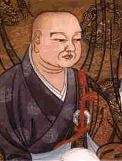Keizan
Keizan Jōkin (Chinese: 瑩山紹瑾, 1268–1325), also known as Taiso Jōsai Daishi,[1] is considered to be the second great founder of the Sōtō school of Zen in Japan. While Dōgen, as founder of Japanese Sōtō, is known as Highest Patriarch (高祖, kōso), Keizan is often referred to as Great Patriarch (太祖, taiso).[2]
Keizan Jōkin Zenji | |
|---|---|
 | |
| Title | Zen Master Daishi |
| Other names | Taiso Jōsai Daishi |
| Personal | |
| Born | Keizan Jōkin 1268 |
| Died | 1325 (aged 56–57) Japan |
| Religion | Zen Buddhism |
| School | Sōtō |
| Other names | Taiso Jōsai Daishi |
| Part of a series on |
| Zen Buddhism |
|---|
 |
|
Persons Chán in China Classical
Contemporary
Zen in Japan Seon in Korea Thiền in Vietnam Zen / Chán in the USA Category: Zen Buddhists |
|
Doctrines
|
|
Awakening |
|
Practice |
|
Schools
|
|
Related schools |
Keizan and his disciples are credited with beginning the spread of Sōtō Zen throughout Japan, away from the cloistered monastic practice characteristic of Dōgen's Eihei-ji, and towards a more popular religion that appealed to all levels of Japanese society. Keizan founded several temples throughout his lifetime, most notably Yōkō-ji and Daihonzan Sōji-ji (founded on the Noto Peninsula and moved to Tsurumi-ku, Yokohama in 1911). Today Sōji-ji and Eihei-ji stand together as the two principal Sōtō Zen training centers in Japan.
Biography
Youth and Zen-training
Keizan spent the first eight years growing up under the care of his grandmother, Myōchi, who was one of Great Master Dōgen's first supporters on his return from China. Keizan always acknowledged a great debt to this grandmother by dedicating the Kannon shrine at the temple of Yōkō-ji to her memory.
Keizan also praised his mother very highly in his autobiography, and even said that his mother's wishes and her constant prayers to Kannon had enabled him to become a monk, receive the Dharma transmission and become one of the Soto Zen Ancestors. His mother had become abbess of a Soto monastery, Jōju-ji (成就寺) and was a teacher in her own right. It seems that his mother had a huge influence both as an example of someone who encouraged the teaching of Buddhism to women and through her emphasis on the power of Kannon, the bodhisattva of compassion.[3]
Keizan first became a novitiate at Eihei-ji at the age of 8 under the tutelage of Gikai, and he was formally ordained at age 13 by Koun Ejō. He reached the stage of non-backsliding while training with Jakuen, and received dharma transmission from Tettsū Gikai at the age of 32. All of this was recorded in his autobiography; he was the first Japanese Zen monk to describe his own life.[4]
Sōji-ji
While Keizan is often spoken of as the fourth generation Dharma heir of Dōgen; many English sources erroneously assume that Keizan held the abbotship of Eihei-ji but he never did so. The fourth generation abbot of Eihei-ji was Giun, who replaced Gikai after the latter was forced out of Eihei-ji in what is known as the sandai sōron. Keizan did succeed Gikai as the second abbot of Daijō-ji, in present day Kanazawa.
However, his major accomplishment which gave rise to his status as "second patriarch" of Sōtō Zen was the founding of Sōji-ji, which soon overshadowed Eihei-ji as the principal Sōtō temple. Sōji-ji eventually became the institutional head of four regional networks with several thousand temples under them. By 1589 the imperial court recognized Sōji-ji as the head temple of the Soto school, above Eihei-ji. The two remained rivals for imperial support but by the time of the Meiji restoration in 1872, they founded a truce, acknowledging this in the form of words that the Sōtō school followed “the maxims of the founding Patriarch, Dōgen, and the aspirations of the late teacher, Keizan.”[5]
Death
Keizan died at Yōkō-ji on the 29th day of the 9th month of 1325, at the age of 58 years. Meiho Sotetsu (1277-1350) became Abbot of Yōkō-ji and Gasan Abbot of Sōji-ji. Both lines of the Dharma Transmission remain important in Japanese Sōtō Zen. (Jiyu-Kennett 2002: 97)
Support for training women
Apart from extending the appeal of Sōtō Zen to the rural population, Keizan made efforts to encourage the training of women in Buddhism. Keizan in his autobiography gave much credit to his grandmother and mother. He regarded their support as vital to his own training, and this must have influenced him.
His mother, Ekan, founded two temples, Hōō-ji, and Jōju-ji which was founded as a convent, and where she was abbess.[6] Keizan's worship of the bodhisattva Guanyin (Kannon in Japanese), who is often represented as a female, stemmed from or was enhanced by his mother's veneration of her.[6] Around 1323 or 1324, he named Myōshō, his cousin (his mother's niece), the abbess of Hōō-ji, a Sōtō Zen convent.[6] Following his mother's example of teaching Buddhism to women, Keizan gave the first Sōtō dharma transmission to a nun to his student Ekyū. Keizan had helped Ekyū by giving her copies of Dōgen's writings transcribed into Japanese to make it easier than Chinese for her to follow.[6]
Keizan had a nunnery constructed near Yōkō-ji (eventually making Sonin the Abbess) and made sure funds were allocated for its continuing survival (Faure 2000: 42). It is believed that five monasteries for female monks were established by Keizan (Matsuo 2010: 143). He also named Sonin, the wife of the original donor of Yōkō-ji, as a Dharma Heir (Faure 2000: 44). Keizan claimed that Sonin was the reincarnation of Myōchi, his grandmother.[6]
Writings
Keizan was the author of a number of works including the "Zazen Yōjinki" and, most famously, the Denkōroku "Transmission of the Light", which is a series of fifty-one sermons which details linearly the Sōtō lineage from Gautama Buddha through the Indian Patriarchs, from Bodhidharma and the Chinese Patriarchs, and finally the Japanese patriarchs Dōgen and his immediate successor at Eihei-ji, Ejō.
Legacy
Keidō Chisan Kohō Zenji, Abbot of Sōji-ji in the 1960s, wrote in Sōtō Zen:
In religions, on the one hand, we must go forward ever deepening our religious experiences, while, on the other hand, recognizing our mission to guide other people to the depths of our own experience. We must enable them to know the joy that comes from the knowledge of the Dharma and the bliss that comes from the practice of meditation. It is absolutely essential to have a personal character like that of Great Master Keizan in order to carry out this mission. To regard all people with warm affection, to become the friend of the common people, to enter the realm of the ideal together with them and to share one's joy with others – these are the characteristics of the true man of religion. The Sōtō School believes that it is able to fulfill its basic mission because of the stern father-like character of Dōgen and the compassionate mother-like character of Keizan.[7]
Notes
- Pussel, Ryofu (2010). A Critical Analysis of the Buddhist 88-Temple Pilgrimage on Shikoku Island. Xlibris. p. 39. ISBN 1-4535-3665-5.
- Heine, Steven (2008). Zen Skin, Zen Marrow: Will the Real Zen Buddhism Please Stand Up?. Oxford University Press. p. 88. ISBN 0-19-532677-6.
- Bodiford 1993: ch 8 & 248
- Faure 2000:31
- Bodiford 1993: chapter 8
- Bodiford, William M. (2008) [1993]. Sōtō Zen in Medieval Japan. University of Hawaii Press. pp. 90, 96. ISBN 0-8248-3303-1.
- Keidō Chisan 1960: 69-70
References
- Zen is Eternal Life, P. T. N. Jiyu Kennett, Shasta Abbey Press, 4th edition, 2000, ISBN 0-930066-20-0
- The Wild White Goose, P. T. N. Jiyu Kennett, Shasta Abbey Press, 2nd edition, 2002, ISBN 0-930066-23-5
- Nearman, Hubert, trans. (2001). Keizan Zenji, Denkoroku, , Shasta Abbey Press, 2001, ISBN 0-930066-22-7
- Visions of Power, Bernard Faure, Phyllis Brooks, Published by Princeton University Press, 2000 ISBN 0-691-02941-5, ISBN 978-0-691-02941-2
- Sōtō Zen in Medieval Japan, William M. Bodiford, University of Hawaii Press, 1993, ISBN 0-8248-1482-7
- Sōtō Zen, Keidō Chisan Kohō Zenji, originally published 1960 Sōji-ji Temple, Yokohama Japan, ISBN 0-930066-09-X. Available from Shasta Abbey Press, www.shastaabbey.org.
- History of Japanese Buddhism, Matsuo Kenji, Global Oriental, 2010, ISBN 1-905246-59-5
- McRae, John; Tokiwa, Gishin; Yoshida, Osamu; Heine, Steven, trans. (2005). Zen texts, Berkeley, Calif.: Numata Center for Buddhist Translation and Research (Advice on the practice of Zazen by Keizan)
| Buddhist titles | ||
|---|---|---|
| Preceded by Tettsū Gikai |
Sōtō Zen patriarch 1309–1325 |
Succeeded by Gasan Jōseki & Meiho Sotetsu |